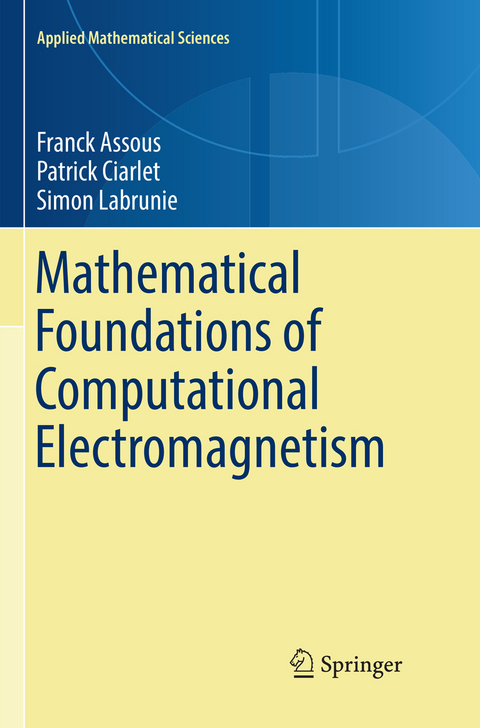
Mathematical Foundations of Computational Electromagnetism
Springer International Publishing (Verlag)
978-3-030-09997-8 (ISBN)
This book presents an in-depth treatment of various mathematical aspects of electromagnetism and Maxwell's equations: from modeling issues to well-posedness results and the coupled models of plasma physics (Vlasov-Maxwell and Vlasov-Poisson systems) and magnetohydrodynamics (MHD). These equations and boundary conditions are discussed, including a brief review of absorbing boundary conditions. The focus then moves to well-posedness results. The relevant function spaces are introduced, with an emphasis on boundary and topological conditions. General variational frameworks are defined for static and quasi-static problems, time-harmonic problems (including fixed frequency or Helmholtz-like problems and unknown frequency or eigenvalue problems), and time-dependent problems, with or without constraints. They are then applied to prove the well-posedness of Maxwell's equations and their simplified models, in the various settings described above. The book is completed with a discussion of dimensionally reduced models in prismatic and axisymmetric geometries, and a survey of existence and uniqueness results for the Vlasov-Poisson, Vlasov-Maxwell and MHD equations.
The book addresses mainly researchers in applied mathematics who work on Maxwell's equations. However, it can be used for master or doctorate-level courses on mathematical electromagnetism as it requires only a bachelor-level knowledge of analysis.
Foreword.- Physical framework and models.- Electromagnetic fields and Maxwell's equations.- Stationary equations.- Coupling with other models.- Approximate models.- Elements of mathematical classifications.- Boundary conditions and radiation conditions.- Energy matters.- Bibliographical notes.- Basic applied functional analysis.- Function spaces for scalar fields.- Vector fields: standard function spaces.- Practical function spaces in the (t, x) variable.- Complements of applied functional analysis.- Vector fields: tangential trace revisited.- Scalar and vector potentials: the analyst's and topologist's points of view.- Extraction of scalar potentials and consequences.- Extraction of vector potentials.- Extraction of vector potentials - Vanishing normal trace.- Extraction of vector potentials - Complements.- Helmholtz decompositions.- Abstract mathematical framework.- Basic Results.- Static problems.- Time-dependent problems.- Time-dependent problems: improved regularity results.- Time-harmonic problems.- Summing up.- Analyses of exact problems: first-order models.- Energy matters: uniqueness of the fields.- Well-posedness.- Analyses of approximate models.- Electrostatic problem.- Magnetostatic problem.- Further comments around static problems.- Other approximate models.- Analyses of exact problems: second-order models.- First-order to second-order equations.- Well-posedness of the second-order Maxwell equations.- Second-order to first-order equations.- Other variational formulations.- Compact imbeddings.- Improved regularity for augmented and mixed augmented formulations.- Analyses of time-harmonic problems.- Compact imbeddings: complements.- Free vibrations in a domain encased in a cavity.- Sustained vibrations.- Interface problem between a dielectric and a Lorentz material.- Comments.- Dimensionally reduced models: derivation and analyses.- Two-and-a-half dimensional (2 1/2 2D) models.- Two-dimensional (2D) models.- Some results of functional analysis.- Existence and uniqueness results (2D problems).- Analyses of coupled models.- The Vlasov-Maxwell and Vlasov-Poisson systems.- Magnetohydrodynamics.- References.- Index of function spaces.- Basic Spaces.- Electromagnetic spaces.- Dimension reduction and weighted spaces.- Spaces measuring time regularity.- List of Figures.- Index.
"The monograph provides useful mathematical tools for investigations of some problems for electromagnetic fields and their computational realizations." (Vasil G. Angelov, zbMATH 1452.78001, 2021)
"This book presents an in-depth treatment of various mathematical aspects of electromagnetism and Maxwell's equations. ... The text is entirely self-contained, assuming from the reader only an undergraduate-level background in analysis. It is suitable for students and researchers in applied mathematics interested in Maxwell's equations and their approximate or coupled models." (Agustin Martin, Mathematical Reviews, January, 2019)
| Erscheinungsdatum | 21.01.2019 |
|---|---|
| Reihe/Serie | Applied Mathematical Sciences |
| Zusatzinfo | IX, 458 p. 7 illus. |
| Verlagsort | Cham |
| Sprache | englisch |
| Maße | 155 x 235 mm |
| Gewicht | 712 g |
| Themenwelt | Mathematik / Informatik ► Mathematik ► Angewandte Mathematik |
| Naturwissenschaften ► Physik / Astronomie ► Theoretische Physik | |
| Schlagworte | electromagnetic Darwin model • electrostatic problem • Helmholtz decomposition • linear Vlasov equation • Magnetohydrodynamics • magnetostatic field problem • magnetostatics • Maxwell Equations • time harmonic electromagnetic fields • Vlasov Maxwell equation • Vlasov Maxwell model • Vlasov Maxwell system • Vlasov Poisson equation • Vlasov Poisson systems |
| ISBN-10 | 3-030-09997-0 / 3030099970 |
| ISBN-13 | 978-3-030-09997-8 / 9783030099978 |
| Zustand | Neuware |
| Informationen gemäß Produktsicherheitsverordnung (GPSR) | |
| Haben Sie eine Frage zum Produkt? |
aus dem Bereich


